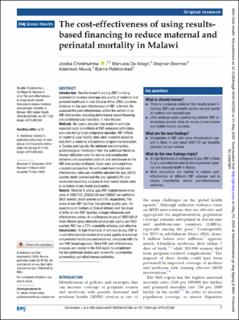| dc.contributor.author | Chinkhumba, Jobiba Joe Henderson | |
| dc.contributor.author | De Allergi, Manuela | |
| dc.contributor.author | Brenner, Stephan | |
| dc.contributor.author | Robberstad, Bjarne | |
| dc.date.accessioned | 2021-05-10T07:11:59Z | |
| dc.date.available | 2021-05-10T07:11:59Z | |
| dc.date.created | 2021-01-28T10:05:33Z | |
| dc.date.issued | 2020 | |
| dc.identifier.issn | 2059-7908 | |
| dc.identifier.uri | https://hdl.handle.net/11250/2754477 | |
| dc.description.abstract | Introduction
Results-based financing (RBF) is being promoted to increase coverage and quality of maternal and perinatal healthcare in sub-Saharan Africa (SSA) countries. Evidence on the cost-effectiveness of RBF is limited. We assessed the cost-effectiveness within the context of an RBF intervention, including performance-based financing and conditional cash transfers, in rural Malawi.
Methods
We used a decision tree model to estimate expected costs and effects of RBF compared with status quo care during single pregnancy episodes. RBF effects on maternal case fatality rates were modelled based on data from a maternal and perinatal programme evaluation in Zambia and Uganda. We obtained complementary epidemiological information from the published literature. Service utilisation rates for normal and complicated deliveries and associated costs of care were based on the RBF intervention in Malawi. Costs were estimated from a societal perspective. We estimated incremental cost-effectiveness ratios per disability adjusted life year (DALY) averted, death averted and life-year gained (LYG) and conducted sensitivity analyses to how robust results were to variations in key model parameters.
Results
Relative to status quo, RBF implied incremental costs of US$1122, US$26 220 and US$987 per additional DALY averted, death averted and LYG, respectively. The share of non-RBF facilities that provide quality care, life expectancy of mothers at time of delivery and the share of births in non-RBF facilities strongly influenced cost-effectiveness values. At a willingness to pay of US$1485 (3 times Malawi gross domestic product per capita) per DALY averted, RBF has a 77% probability of being cost-effective.
Conclusions
At high thresholds of wiliness-to-pay, RBF is a cost-effective intervention to improve quality of maternal and perinatal healthcare and outcomes, compared with the non-RBF based approach. More RBF cost-effectiveness analyses are needed in the SSA region to complement the few published studies and narrow the uncertainties surrounding cost-effectiveness estimates. | en_US |
| dc.language.iso | eng | en_US |
| dc.publisher | BMJ Publishing Group | en_US |
| dc.rights | Navngivelse-Ikkekommersiell 4.0 Internasjonal | * |
| dc.rights.uri | http://creativecommons.org/licenses/by-nc/4.0/deed.no | * |
| dc.title | The cost-effectiveness of using resultsbased financing to reduce maternal and perinatal mortality in Malawi | en_US |
| dc.type | Journal article | en_US |
| dc.type | Peer reviewed | en_US |
| dc.description.version | publishedVersion | en_US |
| dc.rights.holder | Copyright Author(s) (or their employer(s)) 2020 | en_US |
| dc.source.articlenumber | e002260 | en_US |
| cristin.ispublished | true | |
| cristin.fulltext | original | |
| cristin.qualitycode | 1 | |
| dc.identifier.doi | 10.1136/bmjgh-2019-002260 | |
| dc.identifier.cristin | 1880983 | |
| dc.source.journal | BMJ Global Health | en_US |
| dc.identifier.citation | BMJ Global Health. 2020, 5 (5), e002260. | en_US |
| dc.source.volume | 5 | en_US |
| dc.source.issue | 5 | en_US |

